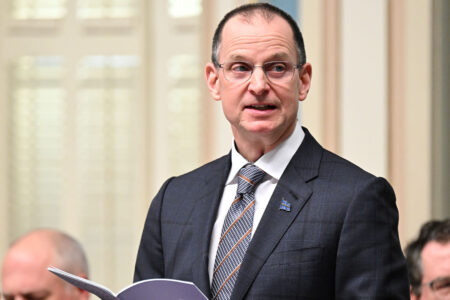
(Version française disponible ici)
Quebec has announced a set of controversial policy changes aimed at reducing the number of people from outside the province or the country studying in English at universities in Quebec.
Confusion arose immediately because of the government’s stunningly unhelpful media release announcing what is actually two complicated sets of interrelated policies on tuition and funding.
Higher Education Minister Pascale Déry says the changes will decrease enrolment at English universities while raising more money, which the province says it will in turn give to French-language universities. French Language Minister Jean-François Roberge defended the changes as a way to protect the French language, saying non-Quebec university students who don’t speak French are contributing to the anglicization of Montreal.
The province’s anglophone universities, the mayor of Montreal, the Montreal chamber of commerce, as well as Quebec’s largest employers’ group and other critics, say the moves will not only hurt those universities financially because they will reduce the number of Canadian students from other provinces, but also have negative effects on Montreal itself and on Quebec’s ability to attract the Canadian and international talent.
Given the confusion from the original announcement and the critical reaction, I’m going to give you my best shot at explaining what actually was announced and what the effects will be.
International student impact
The first part of the recent changes concerns international students. Mostly, the government’s announcement reversed a policy change implemented by the then-governing Quebec Liberal Party just before losing power.
Before 2018, while international students paid higher fees than students from Quebec, the difference between domestic and international tuition was clawed back by the Quebec government and the proceeds redistributed across the university system. (A few students from France and Belgium are exempt from paying higher fees under international tuition reciprocity agreements.)
Since 2018, the provincial government allowed institutions to keep funds generated by international student tuition. At the same time, it removed international students from the province’s enrolment-based funding calculations, which reduced the net benefit to universities somewhat. In effect, it put Quebec universities on a similar footing to those in other provinces when it came to raising revenue from international students.
As Figure 1 shows, this was more beneficial to anglophone universities, where these higher-paying international students make up roughly 23 per cent of the student body, than to francophone ones, where international students make up 14 per cent, according to 2023 data from the Bureau de Coopération Interuniversitaire.
The financial gap between English and French universities is actually bigger than Figure 1 suggests because the international student fees are higher at anglophone universities. However, the schools do not break down tuition figures between Canadian and international students, so precise data is lacking.
The recent announcement re-introduces the government clawback for everything between the Quebec student fee of about $3,000 and the international student fee, which will start at a “minimum threshold” reported to be $20,000. The educational institutions get to keep everything above that threshold but it’s best to think of the change as a raid of $17,000 per international student by the provincial government.
To balance that somewhat, international students are being put back into the enrolment-based funding equation. The end result depends on which fields international students are enrolled in at each institution, but my guess is that this probably offsets about 60 per cent of the loss.
It’s not clear how the balance will be redistributed across institutions – the Quebec press release implies it will be delivered only to francophone universities – but it is possible that this just means that it will go to all universities in line with enrolments. Either way, francophone universities will be the only net beneficiaries.
As Figure 1 shows, no matter how it gets redistributed, it will undoubtedly be good news for Sherbrooke and some of the less internationally minded Université du Québec campuses (e.g. Abitibi-Témiscamingue) and bad news for McGill and Concordia.
Impact on Canadians
The other part of the tuition announcement concerned Canadian students from outside Quebec. Since 1996, Quebec has charged them higher fees, like all provinces do for international students. (Some Nova Scotia universities also charge higher tuition for Canadian out-of-province students, but the extra amounts are much smaller than the extra fees charged in Quebec. Nova Scotia has the highest tuition fees in the country while Quebec has the lowest.)
The Quebec fees for Canadian students from outside the province were initially pegged to the average of tuition fees in the other nine provinces but has gradually drifted higher over time and is currently about $9,000 per year – roughly three times what Quebec students pay. Other fees are charged on top of that. As with international students prior to 2018, the difference between the two tuition levels was always clawed-back by Quebec for re-distribution.
The Legault government has decided to raise the basic fee for Canadian students from outside Quebec to an amount that was left unspecified but is widely understood, based on government briefings, to be a doubling of fees – to around $18,000 per student per year, starting in 2024. The entirety of this increase will be clawed back by the government, as has been the case since 1996.
But the real point of this measure is not to raise revenue as much as it is to make Quebec universities – in particular, the anglophone trio of McGill, Concordia and Bishop’s – financially unattractive to non-Quebecers and to “change Montreal’s linguistic profile,” as Roberge said.
In a gesture to French-speaking students coming to Quebec from other parts of Canada, the Legault government has enacted separate legislation that removes the extra payment for students from other parts of Canada – but if and only if they study in French in a program offered only in Quebec.
This measure had no effect on institutional finances, but it did create the precedent that at least some students in French programs would pay less than those in English ones. I was unable to find any data on how many students benefit from this policy. My guess is that it affects only a small minority of francophone students.
Nor are there very solid numbers about any other out-of-province students in Quebec, although it seems clear that the largest numbers are at McGill and Concordia, while the francophone universities combined probably account for only about 20 per cent of the total.
The bottom line
So what are the financial implications of all this? I can’t share exact calculations because none of the institutions (and certainly not the province) provide data in quite enough detail to work it out. But here’s my best estimate.
The international student policy
The $17,000-per-student claw-back is going to cost McGill and Concordia somewhere between $100 million and $150 million each, and Bishop’s around $6.5 million per year.
Proportionately, this hits Concordia by far the worst because it represents 12-13 per cent of its total income, whereas for McGill and Bishop’s the proportion is more like six to eight per cent of their total annual income.
They will get some of this back – how much we don’t know – through international students being reinstated in the weighted enrolment calculation and possibly some through redistribution of funds.
The out-of-province student policy
The full effect of this will take three to four years to kick in because current students are grandfathered. But assuming that the higher tuition fee costs Concordia and Bishop’s three-quarters of their out-of-province students and McGill half (McGill’s brand probably makes the demand for its spaces a little less elastic than the other two), then the fully phased-in hit to the three universities from both the loss of fees and enrolment-weighted funding is about $5 million a year at Bishop’s, $18 million a year at Concordia and $32 million a year at McGill. In the first year, it will be about 30 per cent of that.
That is if all other things are equal, of course. All these institutions will do what they can to raise money in other ways. All of them, I suspect, will seek more international students to make up for the losses.
McGill might be able to make that work well enough to offset all its revenue losses, but I suspect it will be more difficult for Bishop’s and Concordia.
The way the financial incentives are currently structured, it is highly unlikely that the government will meet its goal of reducing the number of English-speaking students in Montreal. International students will simply replace out-of-province ones.
Perhaps most importantly, Canadians outside the province will have reduced access to an important educational hub, one where people come from across the country to come learn from Quebecers and about Quebec. It is a loss for the province and the entire country.







